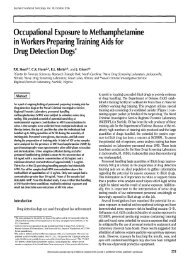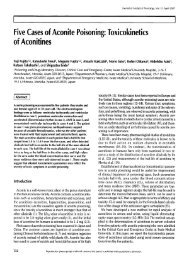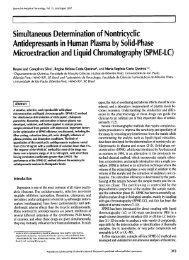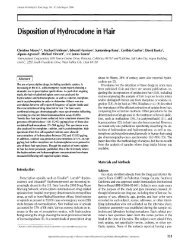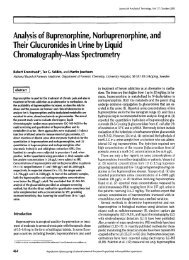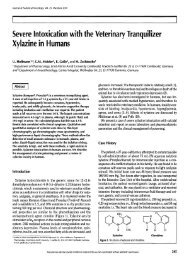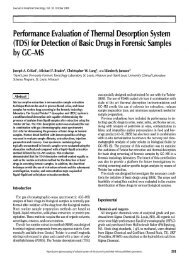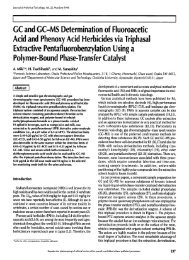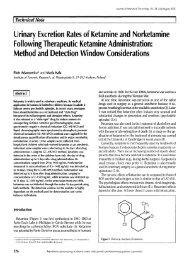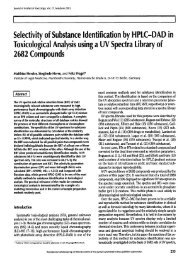Fatal Seizures Due to Potential Herb-Drug Interactions - Journal of ...
Fatal Seizures Due to Potential Herb-Drug Interactions - Journal of ...
Fatal Seizures Due to Potential Herb-Drug Interactions - Journal of ...
You also want an ePaper? Increase the reach of your titles
YUMPU automatically turns print PDFs into web optimized ePapers that Google loves.
Case His<strong>to</strong>ry<br />
The decedent, a 55-year-old male, was swimming at a health<br />
club with an attendant walking alongside as he swam, when he<br />
suddenly went underwater and lost consciousness. The two life-<br />
guards at the pool immediately pulled him out, and one <strong>of</strong> them<br />
initiated CPR; paramedics were summoned. There was an initial<br />
report <strong>of</strong> a seizure in the pool, but it could not be corrobo-<br />
rated. During the time that the paramedics attempted resusci-<br />
tation, they encountered a pulseless rhythm, ventricular fibril-<br />
lations, and ventricular tachycardia. The patient received<br />
defibrillation and intravenous advanced cardiac life support<br />
medications including epinephrine, bicarbonate, and normal<br />
saline. At the ER, he was observed <strong>to</strong> be lifeless and cyanotic,<br />
with an absence <strong>of</strong> spontaneous movements or respirations.<br />
Pulmonary sounds were symmetric, with bilateral coarse rales<br />
and rhonchi. The pupils were fixed and dilated with an absence<br />
<strong>of</strong> corneal and doll's eye reflexes. The nail beds were cyanotic,<br />
and the patient was flaccid with an absence <strong>of</strong> neurological re-<br />
sponses. The patient was pronounced dead, and an au<strong>to</strong>psy was<br />
indicated. Au<strong>to</strong>psy results revealed evidence <strong>of</strong> an old cerebral<br />
infarct and severe coronary vascular disease, as well as an old<br />
myocardial infarct and prior bypass surgery. The <strong>to</strong>xicological<br />
analyses involved a broad-based gas chroma<strong>to</strong>graphy (GC)<br />
screen for acidic/neutral drugs, with confirmation by GC-mass<br />
spectroscopy (MS). Trinders' test was used <strong>to</strong> check for salicy-<br />
lates, and headspace GC was used for analysis <strong>of</strong> volatiles. Chem-<br />
Elut columns were used for GC. The <strong>to</strong>xicological analysis re-<br />
vealed a femoral blood valproic acid (Depakote) level <strong>of</strong> less<br />
than 26 IJg/mL and a pheny<strong>to</strong>in (Dilantin) level <strong>of</strong> 2.5 IJg/mL.<br />
Caprillic acid and para-methyl pheny<strong>to</strong>in were used as internal<br />
standards for valproic acid and pheny<strong>to</strong>in, respectively. Both<br />
the anti-epileptic drugs were considered <strong>to</strong> be subtherapeutic at<br />
these levels. The cause <strong>of</strong> death was ruled <strong>to</strong> be a seizure disorder<br />
due <strong>to</strong> an old cerebrovascular event. According <strong>to</strong> his medical<br />
records, the patient had been in sound health until a year prior<br />
<strong>to</strong> his demise, when he experienced a cerebrovascular accident<br />
following coronary artery bypass surgery, after which he devel-<br />
oped a seizure disorder. His medical records revealed that, on<br />
three occasions, his anticonvulsant (Dilantin, Depakote) serum<br />
drug levels had dipped below the therapeutic range for no ap-<br />
parent reason. Table I provides serum Dilantin levels from the<br />
medical records <strong>of</strong> the deceased. On one occasion, he experi-<br />
Table I. Fluctuations in the Dilantin Levels<br />
Date Dilantin Level Therapeutic Range<br />
4/24/00 4.1 mg/L<br />
5/3/00 10.4 mg/L<br />
7/21/00 14.0 mg/L<br />
8/4/00 9.6 mg/L<br />
8/14/00 10.6 mg/L<br />
8/25/00 13.7 mg/L<br />
9/29/00 21.2 mg/L<br />
10/20/00 14.1 mg/L<br />
11/30/00 13.9 mg/L<br />
756<br />
10 <strong>to</strong> 20 mg/L<br />
<strong>Journal</strong> <strong>of</strong> Analytical Toxicology, Vol. 29, Oc<strong>to</strong>ber 2005<br />
enced a breakthrough seizure with a therapeutic Dilantin<br />
level. Following his demise, it was discovered that apart from<br />
his prescription medications, the deceased was taking copious<br />
nonprescription vitamins, supplements, and herbal nutraceuti-<br />
cals, apparently without the knowledge <strong>of</strong> his physician. He<br />
had begun taking the supplements approximately a year prior<br />
<strong>to</strong> his death. The most common herbal ingredient in these<br />
preparations was ginkgo, an extract from the leaves <strong>of</strong> the<br />
Ginkgo biloba tree. Among the other ingredients were ginseng<br />
and saw palmet<strong>to</strong> extracts. The possible seizure-potentiating<br />
role <strong>of</strong> these herbal products was explored in an extensive liter-<br />
ature study.<br />
Discussion<br />
<strong>Herb</strong>al products have long been popular, and some <strong>of</strong> their<br />
modern derivatives constitute highly prescribed medications<br />
(e.g., the evolution <strong>of</strong> digoxin from foxglove). Although many<br />
herbs have been evaluated in randomized controlled trials, the<br />
limitations <strong>of</strong> poor design, small samples, and uncertain com-<br />
position <strong>of</strong> products make any reliable interpretation impossible.<br />
Furthermore, the absence <strong>of</strong> advisory warning labels addressing<br />
possible adverse effects <strong>of</strong> these nutraceutical agents, make it<br />
imperative <strong>to</strong> study and document any possible drug interac-<br />
tions. The U.S. Food and <strong>Drug</strong> Administration's Special Nutri-<br />
tionals Adverse Effect Moni<strong>to</strong>ring System (SN/AEMS) described<br />
seven reports <strong>of</strong> seizures associated with ginkgo. Four reports<br />
were associated with multi-ingredient products and three were<br />
associated with single-ingredient preparations, each from dif-<br />
ferent manufacturers (10). Several reports in the literature in-<br />
dicate that consumption <strong>of</strong> ginkgo nuts might induce seizure ac-<br />
tivity. After the consumption <strong>of</strong> ginkgo nuts, a previously healthy<br />
36-year-old woman without any past or family his<strong>to</strong>ry <strong>of</strong> epilepsy<br />
developed vomiting and generalized <strong>to</strong>nic and clonic convul-<br />
sions (11). Ginkgo nuts contain a potent neuro<strong>to</strong>xin, 4'-0-<br />
methoxypyridoxine (4'-MPN), which is known <strong>to</strong> indirectly in-<br />
hibit the enzyme activity <strong>of</strong> glutamate decarboxylase, resulting<br />
in decreased levels <strong>of</strong> y-amino-butyric acid (GABA)(12). GABA<br />
is an inhibi<strong>to</strong>ry neurotransmitter, and a reduced concentration<br />
<strong>of</strong> GABA may lead <strong>to</strong> seizure induction (11). The leaves <strong>of</strong> the<br />
ginkgo tree are a source <strong>of</strong> extracts for commercial ginkgo<br />
products. Although the majority <strong>of</strong> commercial ginkgo products<br />
may not contain sufficient 4'-MPN <strong>to</strong> cause seizures, depending<br />
on the harvest season and the potential introduction <strong>of</strong> con-<br />
taminants, 4'-MPN may be present in amounts sufficient <strong>to</strong><br />
cause seizures in a vulnerable populace, such as infants or in-<br />
dividuals with known seizure disorders (13). Arenz et al. (14)<br />
documented the occurrence <strong>of</strong> 4'-MPN in ginkgo leaves and<br />
some commercially available ginkgo preparations. Manocha et<br />
al. (15,16) proposed an alternative mechanism for the putative<br />
seizure activity <strong>of</strong> ginkgo biloba~ They found that ginkgo, a<br />
platelet-aggregating fac<strong>to</strong>r (PAF) antagonist, facilitated strych-<br />
nine-induced convulsions in mice. This study emphasized the<br />
possible modulating effect <strong>of</strong> ginkgo biloba on the inhibi<strong>to</strong>ry<br />
neurotransmitter glycine because strychnine competes with<br />
glycine, thus exerting a central stimulant effect through in-



